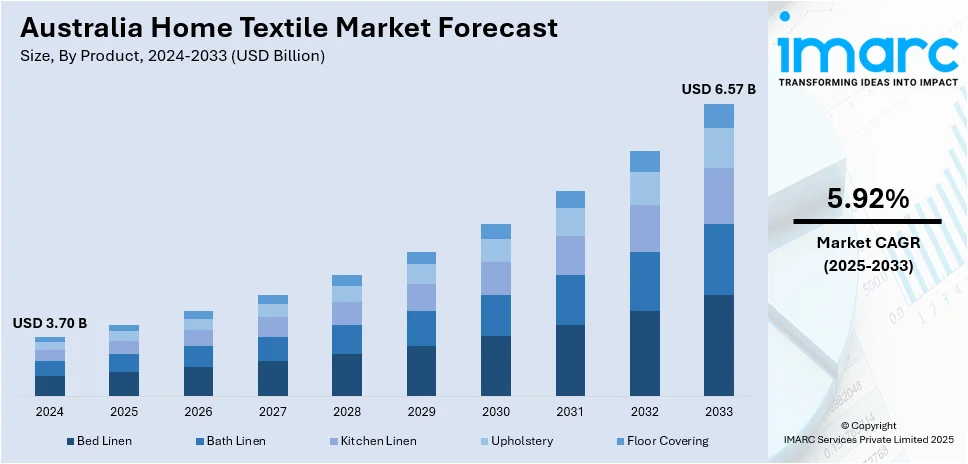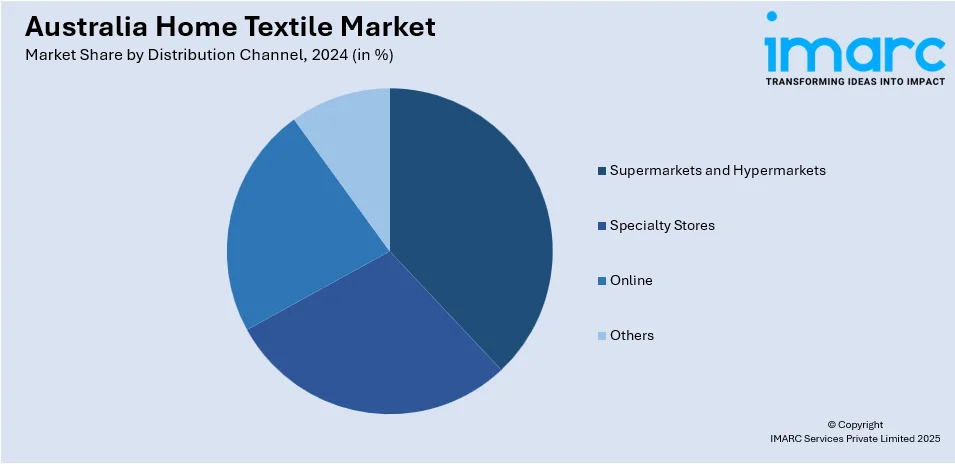
Australia Home Textile Market Size, Share, Trends and Forecast by Product, Distribution Channel, and Region, 2025-2033
Australia Home Textile Market Overview:
The Australia home textile market size reached USD 3.70 Billion in 2024. Looking forward, the market is expected to reach USD 6.57 Billion by 2033, exhibiting a growth rate (CAGR) of 5.92% during 2025-2033. The market is experiencing steady growth, driven by increasing consumer demand for high-quality, stylish, and sustainable home textiles. Products, such as bed linens, curtains, towels, and cushions, are also gaining popularity as consumers focus on home aesthetics and comfort. Rising home renovation trends and growing preference for eco-friendly materials are further contributing to the overall Australia home textile market share.
|
Report Attribute
|
Key Statistics
|
|---|---|
|
Base Year
|
2024
|
|
Forecast Years
|
2025-2033
|
|
Historical Years
|
2019-2024
|
| Market Size in 2024 | USD 3.70 Billion |
| Market Forecast in 2033 | USD 6.57 Billion |
| Market Growth Rate 2025-2033 | 5.92% |
Key Trends of Australia Home Textile Market:
Rising Focus on Sustainability
Sustainability is emerging as a major trend in the Australian home textile sector with consumers becoming increasingly focused on organic and eco-friendly materials when making their purchases. Textiles from natural fibers like bamboo and organic cotton are finding greater demand primarily because of consumers' environmental consciousness and need to cut down on their carbon footprint. For instance, in April 2024, Hommey launched its softest bedding collection crafted from 100% organic cotton and available in 12 colors including signature stripes. Designed for comfort and style the OEKO-TEX certified sheets promise breathability and durability. The collection allows for customizable designs matching perfectly with their iconic robes. Moreover, recycled materials are becoming popular since they represent an eco-friendly alternative to conventional textiles. Numerous brands currently have products constructed from sustainably sourced textiles, eco-friendly dyes, and biodegradable packaging in line with the values of green consumers. This call for sustainability is driven by consumer values and by an industry-wide trend toward corporate responsibility and green efforts within the textile sector. As consumers keep looking for products that are fashionable yet environmentally friendly, the sustainable home textiles market in Australia is likely to expand rapidly.

To get more information on this market, Request Sample
Growing Demand for Customization and Personalization
Consumers in the Australia home textiles market is increasingly seeking personalized products that reflect their individual tastes and preferences. Personalized home textiles such as monogrammed bed linens, custom-made curtains, and unique fabric designs are becoming more popular as consumers move away from mass-produced items. For instance, in June 2024, BEDGEAR launched its first flagship store in Australia at Warringah Mall, Sydney marking its entry into the market. The innovative 120-square-metre space offers personalized sleep system fittings and interactive displays. BEDGEAR aims to enhance customer experience and expand its presence in Australia showcasing high-tech bedding solutions. This is fueled by the need for individuality and increased attachment to home furnishings since customized textiles provide an extra dimension of individuality and exclusivity. The capability to design unique products whether by way of digital platforms or niche stores is allowing consumers to craft textiles that are tailored to their unique requirements and taste. With the increasing demand for customized products companies are adding more opportunities for customization which is catalyzing the Australia home textile market growth.
Growth Factors of Australia Home Textile Market:
Growing Demand for Locally Sourced Textiles
One of the major drivers of growth in the home textile market in Australia is growing customer demand for sustainable, ethically made, and locally sourced textile products. Australians are very eco-conscious, and they express their concern for the environment through their buying habits, especially when it concerns home products. Homeowners today are giving importance to organic cotton, bamboo material, and recycled material for products like bedclothes, curtains, and towels. Australian companies that maintain transparency in sourcing and manufacturing are making more inroads in the market, particularly among young consumers. Additionally, locally produced home textiles are given preference over imported ones, for quality checks and also as they contribute to the local economy. This trend is also supported by the strict environmental policies and increasing demand for ethical labor practices in Australia. Consequently, the call for sustainable and local alternatives continues to play a major role in influencing the direction of the Australia home textile market demand.
Home Renovation and Interior Design Growth
The thriving home renovation and interior design industry in Australia is a key driver for growth within the home textile market. With a robust do-it-yourself (DIY) culture and increasing interest in tailor-made living areas, Australians are spending more on home decor, which encompasses textiles such as cushions, throws, rugs, and drapes. Driven by popular Australian design trends like coastal, minimalist, and modern rustic, consumers are looking for high-quality, fashionable, and functional textiles that fit with these designs. The advent of home-oriented lifestyles, owing to remote work, has generated greater emphasis on comfort and aesthetic pleasures within the home environment. Homeowners are also taking cues from social media influencers, interior designers, and lifestyle shows that encourage seasonal or theme-driven home renovations, generating repeat purchases of new home textiles. This design-oriented cultural emphasis on stylish, comfortable homes plays directly into the growing home textile marketplace, where demand remains high for high-end, design-led products that provide both comfort and visual appeal.
Growth of E-Commerce and Omni-Channel Retail Strategies
According to the Australia home textile market analysis, the quick evolution of e-commerce and online retailing has greatly improved the growth of the industry. With several consumers already buying home products online, it makes sense for textile brands and retailers to be heavily investing in their online presence, with websites, apps, and social media being used to provide convenient shopping experiences. Australia's high internet penetration and technology-oriented consumers make the online market especially fertile ground for expansion. Moreover, omni-channel retailing techniques and merging traditional stores and Web services, enable customers to appreciate the convenience of shopping and browsing while still being able to engage with in-store product experiences. Virtual styling tools, fabric swatches via mail, and augmented reality capabilities for mimicking how fabrics will appear in a consumer's home are provided by most local shops. These technologies enhance consumer confidence and increase conversion rates. The success of these hybrid and digital retail models is further driving the home textile industry, making more products accessible to both the urban and rural regions.
Australia Home Textile Market Segmentation:
IMARC Group provides an analysis of the key trends in each segment of the market, along with forecasts at the country and regional levels for 2025-2033. Our report has categorized the market based on product and distribution channel.
Product Insights:
- Bed Linen
- Bath Linen
- Kitchen Linen
- Upholstery
- Floor Covering
The report has provided a detailed breakup and analysis of the market based on the product. This includes bed linen, bath linen, kitchen linen, upholstery, and floor covering.
Distribution Channel Insights:

- Supermarkets and Hypermarkets
- Specialty Stores
- Online
- Others
A detailed breakup and analysis of the market based on the distribution channel have also been provided in the report. This includes supermarkets and hypermarkets, specialty stores, online, and others.
Regional Insights:
- Australia Capital Territory & New South Wales
- Victoria & Tasmania
- Queensland
- Northern Territory & Southern Australia
- Western Australia
The report has also provided a comprehensive analysis of all the major regional markets, which include Australia Capital Territory & New South Wales, Victoria & Tasmania, Queensland, Northern Territory & Southern Australia, and Western Australia.
Competitive Landscape:
The market research report has also provided a comprehensive analysis of the competitive landscape. Competitive analysis such as market structure, key player positioning, top winning strategies, competitive dashboard, and company evaluation quadrant has been covered in the report. Also, detailed profiles of all major companies have been provided, including:
- Cotex Pty Ltd
- Feltex Carpets
- Greenlit Brands
- Inter IKEA Systems B.V.
- LoomTex Pty Ltd
- Lorraine lea
- Mittal Australia
- Pure Linen
- Sheridan
Australia Home Textile Market News:
- In December 2024, DEIA Living launched a new collection of European-crafted cotton bath robes in the Australian market. Combining luxury and comfort, these unisex robes are crafted from high-quality Egyptian cotton and feature a generous design. The brand specializes in sustainable home linen products, ideal for enhancing everyday routines and making thoughtful gifts for special occasions.
- In December 2024, Enza Home, a Turkish furniture retailer, opened its first Australian flagship showroom in Melbourne, spanning 1500sqm. The store offers a variety of products, including sofas, dining sets, bedroom furniture, lighting, and home textiles. Enza Home aims to inspire unique, elegant living while expanding across Australia.
Australia Home Textile Market Report Coverage:
| Report Features | Details |
|---|---|
| Base Year of the Analysis | 2024 |
| Historical Period | 2019-2024 |
| Forecast Period | 2025-2033 |
| Units | Billion USD |
| Scope of the Report |
Exploration of Historical Trends and Market Outlook, Industry Catalysts and Challenges, Segment-Wise Historical and Future Market Assessment:
|
| Products Covered | Bed Linen, Bath Linen, Kitchen Linen, Upholstery, Floor Covering |
| Distribution Channels Covered | Supermarkets and Hypermarkets, Specialty Stores, Online, Others |
| Regions Covered | Australia Capital Territory & New South Wales, Victoria & Tasmania, Queensland, Northern Territory & Southern Australia, Western Australia |
| Companies Covered | Cotex Pty Ltd, Feltex Carpets, Greenlit Brands, Inter IKEA Systems B.V., LoomTex Pty Ltd, Lorraine lea, Mittal Australia, Pure Linen, Sheridan, etc. |
| Customization Scope | 10% Free Customization |
| Post-Sale Analyst Support | 10-12 Weeks |
| Delivery Format | PDF and Excel through Email (We can also provide the editable version of the report in PPT/Word format on special request) |
Key Benefits for Stakeholders:
- IMARC’s industry report offers a comprehensive quantitative analysis of various market segments, historical and current market trends, market forecasts, and dynamics of the Australia home textile market from 2019-2033.
- The research report provides the latest information on the market drivers, challenges, and opportunities in the Australia home textile market.
- Porter's five forces analysis assist stakeholders in assessing the impact of new entrants, competitive rivalry, supplier power, buyer power, and the threat of substitution. It helps stakeholders to analyze the level of competition within the Australia home textile industry and its attractiveness.
- Competitive landscape allows stakeholders to understand their competitive environment and provides an insight into the current positions of key players in the market.
Key Questions Answered in This Report
The Australia home textile market was valued at USD 3.70 Billion in 2024.
The Australia home textile market is projected to exhibit a CAGR of 5.92% during 2025-2033.
The Australia home textile market is expected to reach a value of USD 6.57 Billion by 2033.
The Australia home textile market trends include a shift toward eco-friendly and organic materials, minimalist and coastal-inspired designs, and the rise of locally crafted products. Consumers are embracing smart textiles, sustainable manufacturing, and seasonal décor updates, while digital platforms and influencer-driven marketing are also shaping purchasing behavior across the country.
The Australia home textile market is driven by growing interest in sustainable products, rising home renovation trends, and increasing demand for stylish, functional interiors. The expansion of e-commerce and omni-channel retail strategies, along with a strong preference for locally made and ethically produced textiles, further fuels the market’s consistent growth.
Need more help?
- Speak to our experienced analysts for insights on the current market scenarios.
- Include additional segments and countries to customize the report as per your requirement.
- Gain an unparalleled competitive advantage in your domain by understanding how to utilize the report and positively impacting your operations and revenue.
- For further assistance, please connect with our analysts.
 Request Customization
Request Customization
 Speak to an Analyst
Speak to an Analyst
 Request Brochure
Request Brochure
 Inquire Before Buying
Inquire Before Buying




.webp)




.webp)












